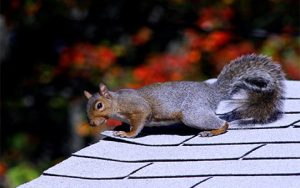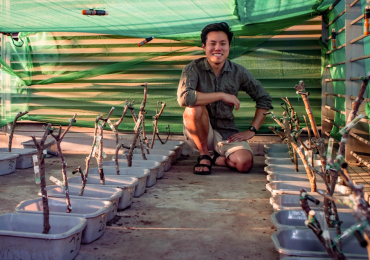In this blog post, we’re looking at a familiar (and often un-welcomed) six-legged friend – the cockroach! Discussing the recently published paper: “In good form: morphological adaptations to burrowing lifestyles in cockroaches (Dictyoptera: Blattodea)“, author Barbara Bignon helps challenge our perspective on roaches by exploring where they like to hang out! By focusing on the ecomorphological correlations of where cockroaches are recorded, Barbara shares fascinating insights as to how body characteristics can have a major and unexpected impact on where cockroaches are found. Outside research, hike-loving, nature explorer Barbara shines an important light on how curiosity leads to interesting findings for some of our understudied species!
1. About the Paper
When most people think of cockroaches, they tend to picture the infamous “urban” roaches—unwelcome visitors to our kitchens, associated with dirt, damage, and disgust. Yet, despite their bad reputation, these species represent less than 0.5% of cockroach diversity. The vast majority of cockroaches, or “country” roaches to allude to one of de la Fontaine’s poems, live quietly in forests, under bark, in soil, or even in sand. Far from being pests, they play vital roles in ecosystems, especially as decomposers. These overlooked cockroaches were the focus of our study.
Our ecomorphological study explores the correlations between cockroach microhabitats (such as wood, litter, tree holes and sand) and their morphology. Some of these microhabitats may appear constraining or challenging, and may have led to the evolution of specific morphological adaptations. For instance, certain shapes appear to be well-suited to specific microhabitats, as illustrated by the ‘pancake syndrome’ observed in species that live under bark and are spectacularly dorso-ventrally flattened. Nevertheless, the relationship between form and microhabitat in cockroaches has never before been formally characterized and studied within a large comparative and evolutionary framework.
Some of our results confirmed some intuitive observations and educated guesses, as illustrated by wood-burrowers that have a relatively elongated body or by sand-diggers with a proportionately shorter and wider body. But other results were unexpected and unforeseen. Sand-dwellers, for example, carry long, wide spines, whereas species living under bark or inside deadwood tend to have shorter, thinner ones. The pronotum, the first dorsal thoracic segment, also showed unexpected patterns. In deadwood burrowers, the anterior and lateral margins of the pronotum were, respectively, truncated and compressed, while they were comparatively broader and more rounded in sand-dwellers and subcorticolous species.
Perhaps the most intriguing part of our study was investigating whether morphology could reliably predict a species microhabitat. Although, this first attempt gave mixed results, the potential of this predictive approach is exciting. Overall, examining how body form relates to ecological traits provides a clearer view of how species adapt to their microhabitats. The implications extend far beyond cockroaches, offering valuable insights into functional ecology and highlighting the intricate relationship between form, environment, and evolution.
2. About the Research
For this project, we examined 62 species of cockroach, chosen to encompass a wide range of phylogenetic, meaning differences in their evolutionary relationships, and morphological diversity. Only female specimens were used to avoid problems related to sexual dimorphism (meaning males are physically different to females), which could be particularly pronounced in some species. All specimens came from the collections of the Muséum national d’Histoire naturelle (MNHN) in Paris, which houses ~1000 species of cockroach. Natural history collections are an exceptional resource, offering access to a wealth of species from various lineages and regions, some of which are impossible to collect in the field today. However, many of these species had never previously been included in a phylogenetic analysis and their microhabitats were unknown. Obviously, the latter could not be sampled to delineate ecomorphs, whereas the former needed to be grafted onto an existing phylogenetic framework, when systematic evidence was available, in order to take their evolutionary history into account in our comparative analyses. These issues drastically reduced our taxonomic sampling.
To characterize cockroach morphology, we combined 13 linear measurements with 3D geometric morphometry data of the pronotum, the first thoracic segment that typically covers the head in cockroaches. These morphological data were analyzed alongside microhabitats. Despite conducting a scoping review of the literature to fully document microhabitats, a major impediment was the lack of knowledge in this area for numerous species. It is precisely this knowledge gap that makes the predictive aspect of our work so valuable: by using morphology to infer microhabitats, we can begin to fill in the blanks where direct ecological observations are lacking. It was thus exciting to find that, of the six selected species with an unknown microhabitat, three exhibited both body proportions and pronotum shape that pointed to the same microhabitat. This shows that our predictive approach can be successful, even with limited data.
Looking to the future, we envisage three main areas of focus. First, we need to expand taxonomic and character samplings, to include features like pronotal bristles, antennae, wing length, and the tiny pads on cockroach legs. Increasing character sampling should help to strengthen predictive analyses. Second, improving the phylogenetic framework will sharpen our comparative analyses. And third, nothing can replace fieldwork: direct observations of microhabitats and behaviors are essential in fighting current biodiversity shortfalls. Ultimately, we hope that these combined efforts will enable us to extend our predictions to fossil cockroaches, opening a window into the hidden ecological diversity of the past.
3. About the Author
My scientific preoccupation revolves around evolution and how species adapt and diversify in response to their environments. I got into evolutionary ecology almost by accident, driven primarily by my curiosity about how species relate to one another and how these relationships have evolved over time. But my path has been deeply interdisciplinary. I began with systematics, exploring species relationships, before moving towards functional morphology to gain a better understanding of forms and functions. I now integrate physics and behavior to investigate how organisms interact with their environment.
For my PhD, I am studying how the morphology and digging behavior of cockroaches are linked to the physical properties of different substrates. There is still very little information available on many cockroach species—a group that most people overlook despite their incredible ecological diversity—so working with these species is both challenging and exciting. This work allows me to explore what species look like, but also how their forms and behaviors are adapted to their inhabiting environments.
Outside the lab, I love hiking, exploring nature, and collecting insects in their natural habitats.
Like many early-career scientists, I have faced challenges along the way—from limited funding to the difficulties of working with understudied species—but these obstacles have only served to strengthen my curiosity and persistence.
Leave a comment





